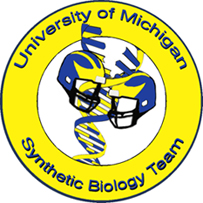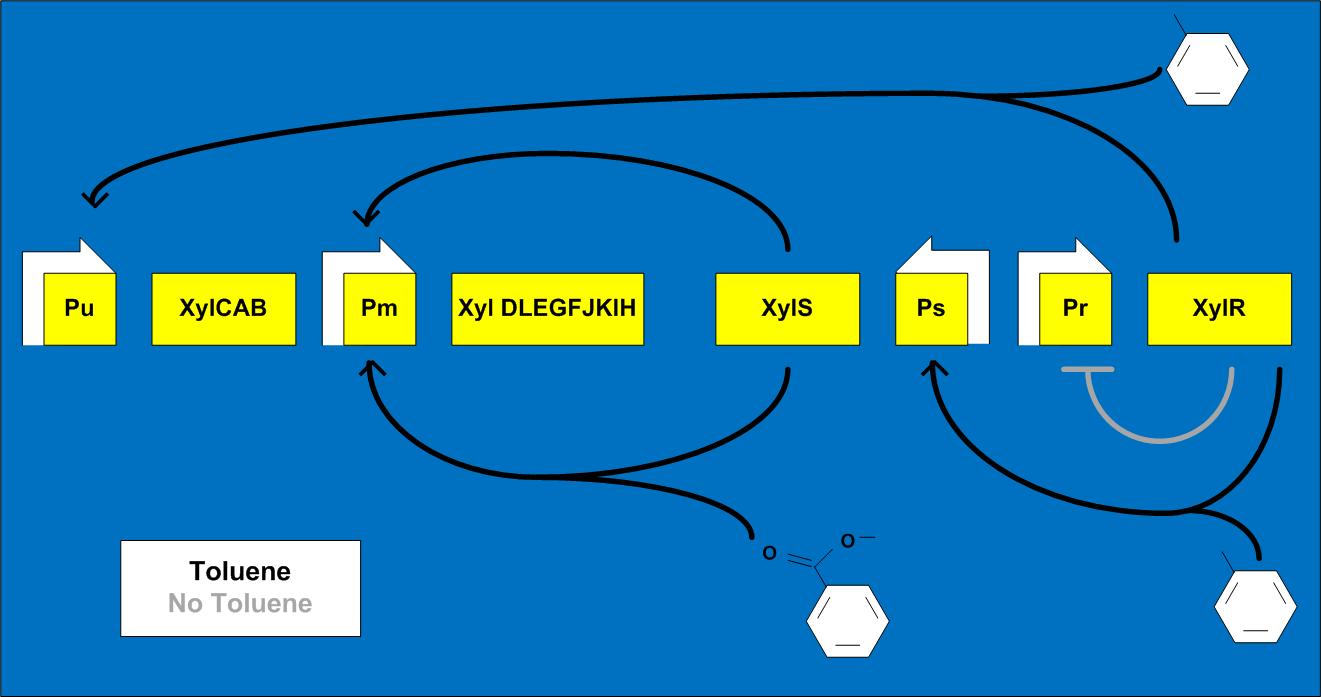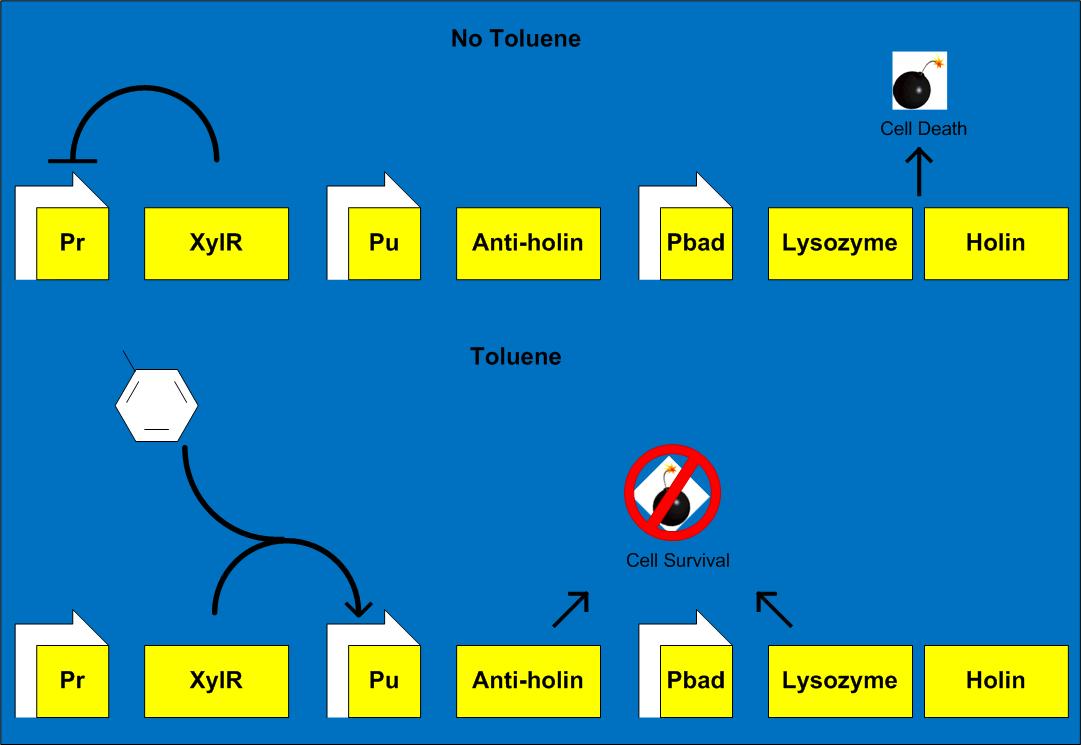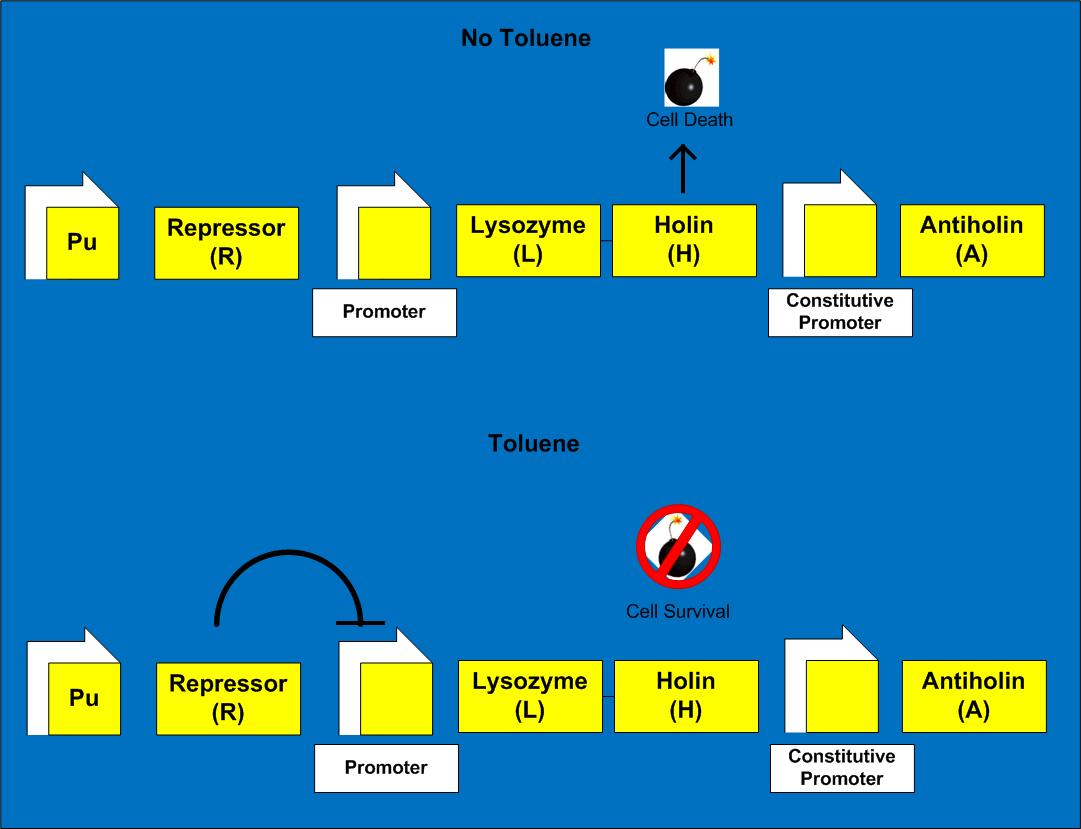Team:Michigan/Project
From 2009.igem.org
(Difference between revisions)
| (31 intermediate revisions not shown) | |||
| Line 8: | Line 8: | ||
| - | ==<B><font size= | + | ==<B><font size=5>Overview</font></B>== |
<div align=justify> | <div align=justify> | ||
| - | The Toluene Terminator is a ''Pseudomonas'' device that aims to identify the toxic compound toluene in an environmental setting (e.g. a spill into soil from an underground petrol tank), move to and uptake it, metabolize it, and destroy itself when all of the toluene has been metabolized. This device will require four basic modules: toluene chemorecognition, chemotaxis, toluene metabolism, and a suicide mechanism. This year we | + | The Toluene Terminator is a ''Pseudomonas putida'' device that aims to identify the toxic compound toluene in an environmental setting (e.g. a spill into soil from an underground petrol tank), move to and uptake it, metabolize it, and destroy itself when all of the toluene has been metabolized. This device will require four basic modules: toluene chemorecognition, chemotaxis, toluene metabolism, and a suicide mechanism. This year we focused on toluene metabolism and the suicide mechanism. |
</div><br> | </div><br> | ||
| - | ==<B><font size= | + | ==<B><font size=5>Toluene Metabolism</font></B>== |
<div align=justify> | <div align=justify> | ||
| - | The goal of this project is to work with the toluene degrading abilities that already exist in ''P. putida'' mt-2 (ATCC 33015) on the pWW0-TOL plasmid. The pathway on this plasmid is comprised of the upper pathway where toluene is metabolized into catechol and the lower | + | The goal of this project is to work with the toluene degrading abilities that already exist in ''P. putida'' mt-2 (ATCC 33015) on the pWW0-TOL plasmid. The pathway on this plasmid is comprised of the upper pathway, where toluene is metabolized into catechol, and the lower meta-pathway, where catechol is converted into acetaldehyde and pyruvate. The regulation of toluene degradation on the pWW0 plasmid is presented below. |
| - | [[Image: | + | [[Image:Toluene_degradation_topology2.jpg|950px]] |
The image is adapted from Burlage, R. S., S. W. Hooper, and G. S. Sayler. 1989. The TOL (pWWO) catabolic plasmid. Appl. Environ. Microbiol. 55: 1323-1328. | The image is adapted from Burlage, R. S., S. W. Hooper, and G. S. Sayler. 1989. The TOL (pWWO) catabolic plasmid. Appl. Environ. Microbiol. 55: 1323-1328. | ||
| Line 36: | Line 36: | ||
<font color=navy> | <font color=navy> | ||
| - | Our project is aimed at characterizing the promoters in the pWW0 plasmid to sense when the toluene degrading process is finished, signaling the cell to commit suicide. The promoter we chose to sense the presence of toluene is the Pu promoter. In order to characterize this promoter we created | + | Our project is aimed at characterizing the promoters in the pWW0 plasmid to sense when the toluene degrading process is finished, signaling the cell to commit suicide. The promoter we chose to sense the presence of toluene is the Pu promoter. In order to characterize this promoter we created [http://partsregistry.org/wiki/index.php?title=Part:BBa_K270003<font color=navy><B>Bba K270003</B></font>], a device that has the Pu promoter expressing GFP. To have this device function in strains other than ''P. putida'' mt-2 that already contains the XylR regulating protein, the part [http://partsregistry.org/wiki/index.php?title=Part:BBa_K270001<font color=navy><B>Bba K270001</B></font>] was created from the Pr XylR portion of the pWW0 plasmid to regulate the Pu promoter. By combining the functions of these two parts, the intensity of GFP can be used to measure the promoter activity when induced with non-lethal level of toluene. |
| - | Currently, we have made the Pu GFP and Pr XylR parts. In the future, we plan on creating one device composed of these two parts and testing the Promoter activity in both ''E. coli'' and ''P. putida''. With this data we will have a better idea of how to link the toluene sensing ability of the Pu promoter with suicide mechanism. | + | |
| + | Currently, we have made the [http://partsregistry.org/wiki/index.php?title=Part:BBa_K270003<font color=navy><B>Pu GFP</B></font>] and [http://partsregistry.org/wiki/index.php?title=Part:BBa_K270001<font color=navy><B>Pr XylR</B></font>] parts. In the future, we plan on creating one device composed of these two parts and testing the Promoter activity in both ''E. coli'' and ''P. putida''. With this data we will have a better idea of how to link the toluene sensing ability of the Pu promoter with suicide mechanism. | ||
<br> | <br> | ||
| - | ==<B><font size= | + | ==<B><font size=5>Suicide Mechanism</font></B>== |
<div align=justify> | <div align=justify> | ||
| - | The Terminator's suicide mechanism, or kill switch, operates through the T4 | + | The Terminator's suicide mechanism, or kill switch, operates through the [http://partsregistry.org/wiki/index.php?title=Part:BBa_K112808<font color=navy><B>Enterobacteria phage T4 Lysis Device</B></font>] created by the Berkley 2008 team. We proposed two mechanisms for cell lysis: arabinose inducible suicide mechanism and suicide mechanism with tunable repression. These two kill switches could both appear, with others, in a final device, considering that severalfold kill switch redundancy will be necessary to prevent "runaway Terminators" (see Safety page). In the both models the Pu promoter is controlling the cell survival and we make the assumption that when the cells are used for bioremediation purposes they are placed in a toluene-contaminated environment. |
| - | + | =<font color=royalblue size=3>Arabinose-Dependent Suicide Mechanism</font>= | |
| + | <font color=navy> | ||
| - | + | This suicide operon consists of an arabinose-dependent promoter controlling expression of the holin and lysozyme proteins, followed by the Pu promoter controlling the antiholin gene shown in the figure below. This way, none of the genes are activated until the device is released into the contaminated area, along with a quantity of arabinose. This results in the arabinose-mediated expression of the lytic genes holin and lysozyme, as well as the toluene-mediated expression of antiholin, which posttranslationally inhibits the lytic proteins. Then, when the toluene disappears (when it is all metabolized) from the local region of the individual device, antiholin is no longer expressed, allowing the lytic proteins to destroy the cell. | |
| - | |||
| - | + | The advantage of this design is the cells can be stored in the absence of arabinose without worrying about expressing the holin and lysozyme. When used in an actual bioremediation application, the arabinose promoter could be changed to a substrate that is already present in the contaminated environment to trigger cell death. This would also help prevent cells from poliferating in the environment after release. | |
| - | + | [[Image:Kill_switch_topology2.jpg|950px]] | |
| + | =<font color=royalblue size=3>Suicide Mechanism with Tunable Repression</font>= | ||
| + | In this design, a repression mechanism is downstream of the Pu promoter, and this this represses the production of holin and lysozyme proteins. A constitutive promoter is placed in the front of the antiholin gene so antiholin is constantly produced. When toluene is present, it activates the Pu promoter which results in the repression of the promoter expressing holin and lysozyme. As a result, the cell survives. However, in the absence of toluene, the repressor protein is not produced, so holin and lysozyme levels rise to the point that the cells are lysed. This design is fairly tunable because we can choose which repression system to use, through which we can tweak the holin-antiholin balance. | ||
| + | |||
| + | |||
| + | The motivation for this design is the Berkeley 2008 design. It used an inducible promoter in front of the holin and lysozyme and this inducible promoter then would trigger the onset of the killing mechanism. In our design, we wanted to use Pu to make the killing mechanism responsive to toluene concentration. However, we needed to set this up such that Pu would prevent cell death. Due to this requirement, we designed an inverter that is comprised of the repression module. This way, we did not have to modify the Berkeley part, which is characterized as working. | ||
| + | |||
| + | |||
| + | It should be noted that this design requires the cells to be stored in media containing substrates that would activate the Pu promoter (e.g. toluene, o-xylene, methyl-benzene)in order to transport the cells to the actual contaminated site. This is because the cells would die in the absence of such substrates. | ||
| + | |||
| + | |||
| + | [[Image:Kill_switch_topology_for_modeling.jpg|950px]] | ||
| + | |||
| + | ==<B><font size=5>Chemotaxis</font></B>== | ||
| + | <div align=justify> | ||
| + | We wanted to link chemotaxis to our project to have the the bacteria seek out toluene in contaminated environments. We planned on engineering ''P. putida'' to swim up toluene gradients. We did a few initial studies to characterize the natural motility of ''P. putida'' and our results showed that ''P. putida'' has chemotaxis abilities. After this first initial study we focused on the other parts of the project. | ||
|} | |} | ||
Latest revision as of 01:21, 22 October 2009
| ||||||||||||||||||||||
|---|---|---|---|---|---|---|---|---|---|---|---|---|---|---|---|---|---|---|---|---|---|---|
 "
"



